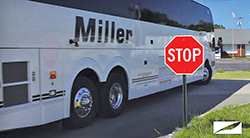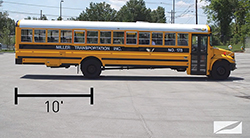
By Todd Carrier

Have you ever come close to making contact with an object or vehicle while turning? Are you aware of how wide the rear of the bus will go as it makes the turn? Turns can be dangerous and costly if you don’t take the necessary precautions before and during these maneuvers. They are among the most common type of accident in the school bus and motorcoach industry.
Most of these accidents are minor and usually involve something small such as a mailbox, mirror or stop sign. However, these accidents can also involve pedestrians and bicyclists, resulting in extensive bodily harm. For example, a right turn in a school bus on a tight residential street may only result in the right rear tire going over someone’s sidewalk or lawn. But a left turn in a motorcoach in a parking lot drop-off situation could knock a pedestrian into a parked car, causing severe bodily injury.
Poorly adjusted mirrors, not knowing the dimensions of the bus, speed and proximity of fixed/moving objects can all contribute to this type of accident. So how can companies avoid turning accidents?
First, always know the length and width of the vehicle. Many school buses have a standard width of 8.5 feet and length of 40-45 feet, while motorcoaches have a standard width of 9 feet and length of 45 feet. Follow company policy on pre-inspections and be sure to take note of the vehicle’s dimensions, especially if you are assigned to a different vehicle than normal.

The rear axle of the bus acts as a pivot point for the rear of the vehicle. However, the distance between the rear axle and the rear of the bus is much greater than that of a passenger car. This part of the bus between the rear axle and rear of the bus is commonly referred to as the “tail swing” because it appears to swing around during a turning maneuver. The tail swing can be 10 feet or more on a standard school bus and almost as much on a motorcoach.
Make sure that mirrors are properly adjusted so you can be sure that the rear of the bus will adequately clear vehicles, pedestrians and objects when it begins the turn. Begin with the driver side mirror. If you can see the windows on the side of the bus, the mirror needs to be pushed out. Remember to check the right side of the bus when turning left and to check the left side of the bus when turning right. And always be certain your vehicle has the right of way before beginning the turn.
During the turn, it’s necessary to ensure that the rear axle is up far enough to keep the bus from pinching objects on the right once the bus begins to pivot to the right. Check the right flat and convex mirrors for space as the bus continues through the turn. Re-check the left mirrors for clearance in the event that a vehicle or person has entered the area where the tail swing has occurred. Once the vehicle has completed the turn, check the mirrors and straighten out the front wheels before accelerating.
When turning from a single lane into a double lane, always turn into the far lane and make the transition to the desired lane well after the turn. When entering a double turn, always stay in the outside lane to avoid a pinch by an outside vehicle.
Finally, it’s important to ensure the vehicle’s pre-trip inspection includes cleaning off the windshields, mirrors and side windows, adjusting the mirrors properly, and knowing the dimensions of the vehicle and tail swing.
Todd Carrier serves as director of risk management for Protective Insurance Company, Carmel, IN. Watch Protective Insurance Company’s “Safety Solutions: Turns and Tail Swings” video online at www.youtube.com/protectiveinsurance. For more information, please email lossprevention@protectiveinsurance.com.
